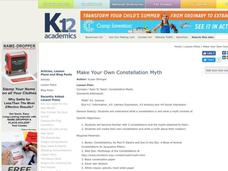Curated OER
Type of Chemical Reactions: Single and double displacements
Students are taught that combustion of carbon in charcoal briquetts produces heat and light. They are shown how to find single displacement and double displacement. Students solve problem set of single and double displacement.
Curated OER
Weather and Oceans: Uneven Heating of the Earth
Learners investigate what causes the heat on Earth. In this Earth heating lesson, students experiment with different heat sources and determine where the Earth gathers the most heat. Learners explore vocabulary words associated with...
Curated OER
Microscopes: Is what you see, what you got?
Eighth graders identify the parts and functions of the microscope. For this biology lesson, 8th graders observe different samples under different types of microscopes. They compare and contrast the details they see.
Curated OER
Introduction to Dissolved Oxygen and Demonstration of a Simple Test Procedure
Young scholars explain the importance of dissolved oxygen in water ecosystems. They describe the aquatic oxygen cycle and the effect of water pollution on oxygen. They make observations, collect data and draw a conclusion.
Curated OER
Butterfly Lesson Plans
Students study the life cycle of the Monarch Chrysalis. In this butterfly life cycle lesson, students study the monarch butterfly life cycle and focus on the fourth stage of the life cycle. Students draw a picture about the fourth stage...
Curated OER
My Five Senses
Students explore their 5 senses. In this 5 senses lesson plan, students participate in activities that require them to use the senses of smell, touch, hearing, taste, and sight.
Curated OER
Altering a Plant Environment
Students investigate what a controlled group is by creating an experiment. In this plant growth lesson, students identify the different parts of a plant and discuss what is needed for a plant to be successfully grown. Students grow a...
Curated OER
Meiosis Lab: Building Baby Reebops
Students review the following vocabulary: Independent assortment, multiple alleles, and polygenic traits. They review their vocabulary by the "quiz, quiz trade" routine. Students work in groups. They are given one set of gene cards...
Curated OER
What is electrical energy?
Students distinguish between items with and without energy. In this energy lesson, students understand that natural resources power electrical apparatus and that energy needs to be saved.
Curated OER
George Washington Carver and Sharing
Students research George Washington Carver. In this science lesson, students discuss George Washington Carver's contribution to science. Students explain how peanut butter is produced.
Curated OER
Make Your Own Constellation Myth
Students examine constellation myths. In this constellation myth lesson, students read "Orion, the Hunter", "Ursa Major, the Great Bear", and Taurus, the Bull". Students discuss similarities and differences in the 3 myths, create...
Curated OER
Solar System
Second graders create planet mobiles in order to reinforce concepts such as planet size, position in relation to the sun, and planet names.
Curated OER
All About Ants
Students create model ants in order to study the characteristics of insects such as body segments, number of legs, and feelers, as well as how these characteristics serve the insect.
Curated OER
The Five Senses
Pupils use their senses to identify a variety of items in mystery boxes after listening to a read aloud of Aliki's, "My Five Senses." They taste and smell items to identify them before completing a Senses Literature Log. They label the...
Curated OER
Finding Caterpillars
Students examine how animals protect themselves from predators and camouflage themselves. They participate in a simulation in which they locate red and green yarn "caterpillars," organize their data, and generate a bar graph using...
Curated OER
Wetland Ecosystems: Non-living and Living Components and Brine Shrimp
Students explore wetland ecosystems. In this wetland lesson, students discuss and observe salt ponds and the organisms that live there. They explain how abiotic and biotic factors of species are important to survival.
Curated OER
Model Mania
Eighth graders study the conservation of matter. In this chemical reaction lesson students examine what happens during a chemical reaction and complete a lab activity.
Curated OER
Living and Non-Living Things | What’s Alive?
Students compare and contrast living and nonliving things. In this classification lesson plan, students read a book featuring living and nonliving things and then sort pictures of living and nonliving things.
Curated OER
Taking Care of Your Teeth
First graders discuss the importance of taking care of their teeth while viewing pictures showing good/poor teeth care. In this health and science lesson, 1st graders list 3 things to do to keep teeth healthy, creating a lis on chart...
Curated OER
The Final Word
Middle schoolers research biographies of Americans who advanced science. They create an obituary for the person to share what information they have gathered. They discuss the importance of the obituary as the "final word" of a person to...
Curated OER
Plate Tectonics
Students watch a video about plate tectonics. in this Earth Science lesson, students watch a video clip from Bill Nye about Continental Drift and Plate Tectonics. They make a slight crack in a hard boiled egg and manipulate the egg to...
Curated OER
Introduction To Fractals: an Inquiry
Students evaluate a playful case study about a dog searching for fetching sticks to identify the steps in the science inquiry method. They read the case study and fill in a worksheet with the examples of questions, observations and...
Curated OER
Photosynthesis: Light-dependent and Calvin cycle
Students recognize the concepts of the light-dependent and the Calvin cycles. They draw diagrams of the light-dependent reaction and the Calvin cycle. In addition, they investigate the effects of light on carbohydrate content in leaves.
Curated OER
TAKS Biology Review
Learners review some TAKS objectives in life science preparing for the upcoming TAKS test. They are given their TAKS review workbook, students look at objectives 1 and 2 in the workbook. Learners review and ask questions about the...

























